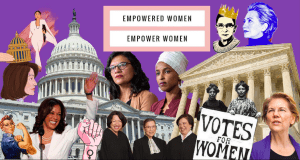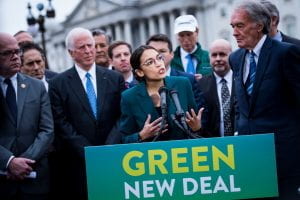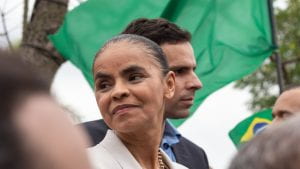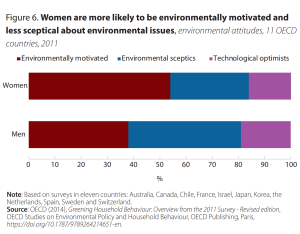There are nearly 334 million people in the United States alone.
There is a sex ratio of 98 males to every 100 females.
As of 2023, there are 7,383 seats in the legislature, yet only 32.7% of those positions are held by women.
That is less than half, only a little over a quarter.
We are in the twenty-first century, yet women are still not elected into at least half of the power making decisions for their nation state, evidence the gender division is still very present and equality is still on the lengthy list of “to-do’s” needed in order for a healthier, happier, and more progressive era in society.
Consider your own list of things to do, perhaps you should be adding research into the next list of electoral candidates and most importantly, voting.

Norgaard and York, authors of “Gender Equality and State Environmentalism” claim, “If women tend to be more environmentally progressive, the inclusion of women as equal members of society–as voters, citizens, policy makers, and social movement participants–should positively influence state behavior” (508).
To further understand this link between gender equality and state environmentalism, let us begin by breaking down the depth of what these terms mean:
Gender equality is to grant equivalent rights and access to opportunities despite gender identification.
Environmentalism is a political movement that aims to take action in protecting the environment for present and future generations.
Norgaard and York discuss the correlation between gender equality and environmental policy through women’s active representation. As discussed in previous blog postings, a society run by patriarchal and capitalist ideologies place male centeredness at the heart of all decision making to acclaim power and privilege over those less advantaged. This results in a society plagued by inequality with those less powerful disproportionately experiencing the harmful effects of environmental degradation, specifically women as gendered divisions of labor, land, and other resources have left them “uniquely and disproportionately affected” (Norgaard and York 507). As gender is socially constructed in society, this places women into the social role of caretaker while men are to be the economic money pot of the family.
Imagine you are a woman, responsible for collection of resources that may be scarce, left to live in an area affected by degradation, and devoted to unpaid domestic labor. Any implications of environmental harm will leave you as the first to experience effects as your social role places you in direct contact with the very land and resources that are being exploited. Norgaard and York connect this with the desire for women to become active advocates in environmentalism as their own life is deeply affected just as much as planet life. The greater the gender equality, the more likely nature is to be protected as women are more likely to care for the support of environmental protection due to direct predisposed risks linking sexism and environmental degradation in the simultaneous devaluation of women and nature (Norgaard and York 508).

The negative reinforcing loop of gender inequality and environmental harm is a result of social structure. Humans did not naturally take advantage of land and humans, but rather, the birth of industrialism and modernization gave way to power over egalitarianism as both women and nature became “invisible under capitalism” (Norgaard and York 509). With men taking control over the social and political economy, women were socialized to become domestic providers. With a gender and social divide, women were left to fight for their wealth, health, and protection as harm against the environment meant harm to their own being.
This is where ecofeminism is essential in understanding “Oppression of the natural world and of women by patriarchal power structures must be examined together or neither can be confronted fully” (Hobgood-Oster 2005). However, although male centered desires are a result of degradation and subjugation, it is important to note that non-Western perspectives of ecofeminism shed light on the health of the environment being in direct connection to women’s survival. Thus, Norgaard and York’s connection between women’s equal political power and environmentalism is crucial when aiming for a positive outlook.
Let us apply their thesis to some examples:
Alexandria Ocasio-Cortez & The Green New Deal

The Green New Deal, proposed by New York Representative, Alexandria Ocasio-Cortez calls for the federal government to “…wean the United States from fossil fuels and curb planet-warming greenhouse gas emissions across the economy” (Friedman 2019). While previous attempts to curb the ever worsening effects of climate change have been in the works, this new movement has stood out with women advocates voicing their concerns as consequences of this environmental degradation are linked to additional social inequalities and racial injustices (Friedman 2019). As both the youngest woman and youngest Latina to ever serve in Congress, her voice was powerful in speaking on behalf of those experiencing social inequalities in communities across the nation. Environmental racism is a significant indicator in deliberate institutional racism that connects the oppression of the environment with issues of race and class (Hobgood-Oster 2005).
Ocasio-Cortez grew up in The Bronx, an environment that experiences the effects of environmental pollution, entangled with gender, race, and class. Her example is just one of many that draw women into key roles in environmental policies. Ocasio-Cortez’s legislation is an example in which “…women both perceive environmental risks as greater and are less willing to impose these risks on others; higher status of women may lead to more environmentally progressive policies as women put their view and values into action” (Norgaard and York 509). Our capitalist social structure has far given into the degradation of the environment ignoring the detrimental effects to those who aren’t granted power privilege. While greenhouse gasses continue to enter the air we breathe to satisfy the greed of corporation giants, those at the opposite end of social structure value health risks of individuals far more than those pocketing the money at the end of the day. Legislation introduced by women such as the bill proposed by Ocasio-Cortez, provides evidence that women’s voices in government place us closer to positive environmental changes for the better social and physical health of the land and other forms of life.
Marina Silva & The Amazon

Marina Silva, a Brazilian environmentalist and politician works to fight against the climate crisis affecting her country as a result of inadequate environmental policies. Appointed as environmental minister, her goals have been to reduce deforestation practices, wildfires, and replace fossil fuel energy with clean energy that will reduce the already exceedingly high carbon footprint (Valencia 2023). During her career, she worked to create 24 million hectares of conservation while doubling natural reserves for traditional indigenous populations who are often most vulnerable amidst environmental degradation (Valencia 2023). As a young girl growing up in the Amazon working on her family farm extracting latex and materials to build their living, she established a deep connection with the land as she recalls it her “economy, identity, and place of fun” (Valencia 2023). As she became an activist and then minister for her country, she aimed her agenda towards the younger generation in hopes to preserve the environment throughout one’s lifetime.
In a country where women account for 52% of the population yet are only 15% of legislators and 11% of ministers, Silva used her voice in being elected as a women environmental minister to grant change in effectively reducing deforestation and providing social and environmental justice to the reserves of the Amazon region. This is important to note as Norgaard and York state their results “…do not necessarily establish that gender equality has a direct causal influence on state environmentalism” but rather they suggest, “…gender equality and state environmentalism are linked and that an understanding of one may contribute to an understanding of another” (515). Silva is an example that despite being a woman in a country that lacks gender equality and representation, positive change can be made when understanding there is a link between women representation in parliament and environmentalism.

Pictured is a chart of statistical data gathered by the Organization for Economic Cooperation and Development (OECD) in which illustrates Norgaard and York’s central thesis in which “…women have more pro-environmental values, are more risk averse, are more likely to participate in social movements, typically suffer disproportionately from environmental degradation, and sexism and environmental degradation can be mutually reinforcing process” (519). Therefore, improving gender equality in political representation will allow an increase in state environmentalism. As described above, 55% of women showed environmental motivation while 30% were environmental skeptics. On the other hand 38% of men showed environmental motivation while 42% were environmental skeptics (OECD 2020). Therefore, with women more environmentally motivated, an increase in political positions will connect to an increase in policies and practices in state environmentalism.
 Take a look at the picture to your left. The statistic above tells us that 55% of women show environmental motivation compared to 38% of men. If we place women in positions of authority, elect them in the political arena, and overall grant gender equality in society, then together they can work together across the globe to improve the environment which radiates to the overall well-being of life across the planet. Our choices are not our own, we are all entangled in a web of cause and effect. One determinant decision of environmental harm impacts a community elsewhere. With women motivated and represented, state environmentalism will be supported.
Take a look at the picture to your left. The statistic above tells us that 55% of women show environmental motivation compared to 38% of men. If we place women in positions of authority, elect them in the political arena, and overall grant gender equality in society, then together they can work together across the globe to improve the environment which radiates to the overall well-being of life across the planet. Our choices are not our own, we are all entangled in a web of cause and effect. One determinant decision of environmental harm impacts a community elsewhere. With women motivated and represented, state environmentalism will be supported.
So, who will you be voting for?
Works Cited:
Friedman, Lisa. “What Is the Green New Deal? A Climate Proposal, Explained.” The New York Times, 21 Feb. 2019, https://www.nytimes.com/2019/02/21/climate/green-new-deal-questions-answers.html.
Hobgood-Oster, Laura. “Ecofeminism: Historic and International Evolution.” Encyclopedia of Religion and Nature, edited by Bron Taylor, Continuum, London & New York , 2005, pp. 533–539, http://www.religionandnature.com/ern/sample/Hobgood-Oster–Ecofeminism.pdf. Accessed 9 Feb. 2023.
Norgaard, Kari, and Richard York. “Gender Equality and State Environmentalism.” Gender & Society, vol. 19, no. 4, 2005, pp. 506–522., https://doi.org/10.1177/0891243204273612.
OECD. “Gender and Environmental Statistics.” Exploring Available Data and Developing New Evidence, 2020, https://www.oecd.org/environment/brochure-gender-and-environmental-statistics.pdf.
Valencia, Robert. “She Grew up in the Amazon, and Now She’s Fighting for Its Life.” Earthjustice, 6 Jan. 2023, https://earthjustice.org/article/she-grew-up-in-the-amazon-and-now-shes-fighting-for-its-life.

Hi Kylie,
Thank you for another great post! I always look forward to reading your insightful comments and analyzing your thoughtful images.
Norgaard and York’s argument that the inclusion of women as equal members of society positively influences state behavior towards environmentalism has gained significant attention in recent years. As you mentioned, women are disproportionately affected by environmental degradation as gendered division of labor, land, and other resources have left them uniquely vulnerable, and this is particularly true in the Global South. As a result, they are more likely to become active advocates in environmentalism as they are directly affected by the impacts of environmental destruction. Unfortunately, the negative reinforcing loop of gender inequality and environmental harm is a result of the social structure that socializes men to take control over the social and political aspects of life while women are socialized to adhere to domesticity.
However, when we apply Norgaard and York’s thesis to the Green New Deal, proposed by Alexandria Ocasio-Cortez, women are brought into key roles in environmental policies. Her legislation has faced many obstacles because it calls out climate denialism and promotes the need for evidence-based policy to address the climate crisis. In this sense, she is helping to combat the ignorance and misinformation that has been propagated by some sectors of society heavily influenced by patriarchy. Environmental racism is also a significant indicator in deliberate institutional racism that connects the oppression of the environment with issues of race and class. By promoting gender equality, women’s participation in society and political representation becomes more significant in environmental policymaking. She is another great example of how women advocates have voiced their concerns about environmental degradation being linked to additional social inequalities and racial injustices.
It was great to see that you also chose Marina Silva to illustrate Norgaard and York’s thesis. Her activism and dedication to protecting the Amazon rainforest and promoting sustainable development has been her life’s work. She has made significant contributions to the preservation of the Amazon rainforest, the “lungs of the world”, as it is widely known, and the promotion of sustainable development. As an Amazon native, she has personally witnessed the devastating effects of deforestation and industrial development on the environment and the communities that rely on it. For decades, she has been a vocal advocate for sustainable development policies that prioritize environmental conservation and the rights of Amazonians, including the indigenous peoples.
Her work closely aligns with the ideas of Norgaard and York who emphasize the importance of female representation in government. Her passion for solving environmental problems and promoting sustainable development, combined with her commitment to cultural and social justice, is what ultimately led her to become a senator (Elomonico 2022), and a key figure in the global environmental movement. Through her advocacy, policies, and efforts to challenge dominant cultural norms, she is a beacon of hope for environmental conservation and social justice in Brazil and joins the ranks of other trailblazing women around the world.
Although I was a teenager at the time, I remember when Chico Mendes was assassinated, and she rallied supporters to continue his work. Her determination and resolve were an inspiration and her courage a cultural phenomenon. As a Brazilian native, I am so proud of her and her amazing work.
If interested, here is the link to her bio page on the Goldman Environmental Prize website. They also offer a video about her younger activism years.
https://www.goldmanprize.org/recipient/marina-silva/#recipient-bio
Works Cited:
Elomonico. “Marina Silva – Goldman Environmental Prize.” Goldman Environmental Prize –, 26 Oct. 2022, http://www.goldmanprize.org/recipient/marina-silva.
Norgaard, Kari Marie, and Richard York. “Gender Equality and State Environmentalism.” Gender & Society, vol. 19, no. 4, SAGE Publishing, Aug. 2005, pp. 506–22. https://doi.org/10.1177/0891243204273612.
Hi Rose,
Thank you for your comment, I appreciate you taking the time to read my blog post! I appreciate that you highlight the criticism Alexandria Ocasio-Cortez’s “Green New Deal” has faced, it is always crucial to understand all perspectives. Despite the judgment she has received, she has used her position as a young woman with political power to propose policies that aim to support environmentalism. As you mention, she is an advocate not only for environmental protection but also for social and racial inequalities. I also wanted to thank you for the additional link to information on Marina Silva’s younger activism years, I will reading further into this; her work is remarkable!
Best,
Kylie C.
n February 2019, Ocasio-Cortez and Massachusetts Senator Ed Markey introduced a resolution outlining the scope of a “Green New Deal.”
Kylie,
Excellent post. I am glad that you included information on Alexandria Ocasio-Cortez. She is one of my favorite politicians, male or female! She is still the youngest female to serve in Congress. I think that fact that she came from a modest background and had to help her mother fight off foreclosure on their house showed her spirit from the start. Her resolution which was reintroduced in 2021, proposed the switch to renewable energy sources for the entire country, with the goal of achieving net-zero greenhouse gas emissions by 2030 is an extremely important initiative. Ocasio-Cortez outlined that the plan called for major investments in clean energy technology research and development. She is planning on including a federal jobs guarantee, basic income and universal health care along with the “Green New Deal”.
In response to her proposal, there are legitimate criticisms that revolve around its stated goal of eliminating the use of fossil fuels in a decade. The proposal calls for using wind and solar power. There are many experts who do not believe it is possible to achieve with these 2 natural resources. This will require electrifying everything, including all home heating and transportation that are currently supplied by fossil fuels. In the end, the need for electricity may triple.
I look forward to watching Ocasio-Cortez as her political career grows.
Catherine
Hi Catherine,
Thank you for your comment, I appreciate you taking the time to read my blog post! I am glad to hear that you also find Alexandria Ocasio-Cortez a crucial voice for women in political representation working to support environmentalism policies. I absolutely agree that her upbringing has contributed to her spirit in combating social, economic, and environmental injustices. As we have discussed this semester, women experience the harmful effects of environmental degradation firsthand, the oppression of women and the environment are connected. Thus, women’s voices such as Alexandria Ocasio-Cortez’s are needed to apply ecofeminist perspectives to policy-making decisions. I too look forward to watching her career grow!
Best,
Kylie C.
Kylie,
I appreciate that you took the time in this piece to really break down the terms that are intrinsic to this argument. Not only does it make the whole piece accessible to all audiences, and therefore the important message can spread further to all people, but it also serves as an excellent summarizing/refresher of the argument as a whole.
Your discussion of women’s “role” as caretakers—collecting resources and domestic labor, reminds me of our previous exploration of how environmental degradation specifically alienates women in the Global South even more so than in the North. So it’s difficult to imagine that the oppression that we notice and the disadvantages we come up against every day are so minuscule in comparision to what women in the Global South face. And this becomes further complicated and disheartening when you look at Norgaard and York’s statistics that “nations more influenced by foreign capital are less likely to ratify environmental treaties.” So in the areas where the devastation is at its most prominent and the women are at an even more drastic disadvantage, they’re even more unlikely to receive the help/support/change that is needed.
It all ties back to that logic of domination and how it is completely at odds with ecological preservation. Knorgaard and York also point out that “although [their] results show capitalist nations are more likely than other nations to participate in environmental treaties, a substantial body of scholarship suggests that capitalism is ecologically unsustainable, both increasing the scale of environmental exploitation and disrupting natural systems.” So, even though it’s the capitalist societies, the ones built on a system of patriarchal hierarchy, that have the power to make environmental change that could positively affect everyone, especially women in the Global South, they end up doing more harm than good. I think that this is because, at its most basic foundation, our system is a hierarchy, and as Carol J Adams pointed out, a hierarchy automatically places someone as superior and someone as lesser. And unfortunately, women and the earth share space at the bottom of the totem pole.
I have hope that organizations like The Women’s Major Group at UNEP will make a difference. It’s a partnership between UNEP and WEDO where the Women’s Major Group prepares policy recommendations and organizes capacity-building and policy events during UNEA and regional meetings of UNEP in an effort to achieve “sustainable development through promoting gender equality and women’s empowerment.”
If you need a little ray of hope after this discussion, check out their mission statement and all their efforts at: unep.org/civil-society-engagement/major-groups-modalities/major-group-categories/women#:~:text=%E2%80%9CWomen%20and%20the%20environment%E2%80%9D%20makes,and%20biodiversity%20conservation%20and%20management.
Hi Kylie – I think you did an excellent job at explaining these topics, and with a unique perspective. Asking someone to visualize being in the position that a lot of women in this world are in can be a helpful tool in order to build empathy for others. If only more people would engage in this exercise to better understand the unique needs of women around the world!
I love that you chose to focus on Alexandria Ocasio-Ortez as an example of a woman in policy. She is a great indication of someone who should be involved in government, as she has a good attitude for it. By that mean, I like that she is fairly outspoken, unapologetic about who she is, and doesn’t let anyone railroad her. I get the sense that she doesn’t let this defeat her either – she knows her own values well, along with the causes she is fighting for. She puts forth an excellent example for younger women who speak their mind and are looking to find jobs that better the world.
Excellent blog here! Also your website loads up very fast!
What host are you using? Can I get your affiliate link to
your host? I wish my site loaded up as quickly
as yours lol
I was suggested this blog by my cousin. I’m not sure whether this post is written by him as
no one else know such detailed about my problem. You are amazing!
Thanks!
You made some really good points there. I looked on the
internet for more info about the issue and found most people will go along with your views on this web site.
Hi there it’s me, I am also visiting this web site daily, this web site is actually pleasant and
the users are actually sharing fastidious thoughts.
I think this is one of the most significant info for me.
And i’m glad reading your article. But want to
remark on few general things, The site style is perfect,
the articles is really nice : D. Good job, cheers
Имя Зyбарёв. Просто, ровно и вне лишних предисловий.
Это именина не нужно рассказывать — оно резонирует, как
сверло по бронзе. Кто слышал, тот осмыслит.
Я не лезу в словеса, я действую.
И если уж за что-то приступаю — значит,
будет завершено. Без выходок, без манёвров.
Делаю спокойно, но итог громкий.
Я Зубарев — значит, не падаю.
Ни на начальном, ни на дальнем ходе.
Против давления, против схем, против предрассудков.
Моё имя — это твердыня, моя цель
— всегда напролом. И пусть кто-то усмехается в ответ
— пусть. Мне не до театра. Я не
для этого пришёл.
my web blog :: zubarev
Вперёд в вселенную онлайн-казино,
где развлечения ожидают прямо в режиме реального времени.
Здесь ты найдёшь востребованные
игровые автоматы, рулетку, и сотни
подарков для новичков и азартных игроков.
Прозрачность — наш фундамент.
Мы предлагаем гарантированные провайдеры от мировых брендов.
Ты можешь делать ставки как на деньги, так
и без риска. Убедись — удача уже на подходе.
my blog post sajtcasino
insurance media site
Here is the translation of the spintax text into Polish, with the original spintax structure preserved:
Cześć, uważam, że to jest doskonały strona.
Natknąłem się na niego 😉 Wrócę ponownie
ponieważ zapisane w zakładkach. Pieniądze i wolność to największy sposób na zmianę,
niech będziesz bogaty i prowadź innym ludziom. który sprawia, że ludzie chcą więcej?
Chodzi mi o to, że Women In Politics Are Saving The Environment – Kylie's Ecofeminism Insights jest
trochę nudny. Powinieneś rzucić okiem na stronę główną Yahoo i zobaczyć, jak oni tworzą posty tytuły,
aby przyciągnąć ludzi otwierających linki. Możesz spróbować dodać
wideo lub powiązane zdjęcie lub dwa, aby przyciągnąć ludzi podekscytowanych tym, co napisałeś.
Moim zdaniem, to mogłoby uczynić twoje posty trochę bardziej żywe.|
Super blog, którą masz tutaj, ale byłem ciekawy, czy znasz jakieś fora społecznościowe, które
dotyczą tych samych tematów dyskutowanych w tym artykule?
Chciałbym naprawdę być częścią społeczności,
gdzie mogę uzyskać sugestie od innych doświadczonych osób,
które mają takie same zainteresowania. Jeśli masz jakieś sugestie, daj mi znać.
Dzięki!|
Cześć bardzo fajny strona internetowa! Facet ..
Doskonały .. Super .. Zaznaczę twój strona internetowa i wezmę kanały dodatkowo?
Jestem zadowolony, że znalazłem tak wiele przydatnych informacji tutaj w poście, chcielibyśmy
opracować więcej technik w tym zakresie, dzięki za udostępnienie.
. . . . .|
Dziś poszedłem na plażę z moimi dziećmi. Znalazłem muszlę
i dałem ją mojej 4-letniej córce i powiedziałem “Możesz usłyszeć ocean, jeśli przyłożysz to do ucha.” Przyłożyła
muszlę do ucha i krzyknęła. W środku był krab pustelnik
i uszczypnął ją w ucho. Nigdy nie chce tam wrócić!
LoL Wiem, że to całkowicie nie na temat, ale musiałem to komuś powiedzieć!|
Kontynuuj to proszę, świetna robota!|
Hej, wiem, że to nie na temat, ale zastanawiałem się, czy znasz jakieś widżety, które mogę
dodać do mojego bloga, które automatycznie tweetują moje
najnowsze aktualizacje na Twitterze. Szukałem takiej wtyczki od
dłuższego czasu i miałem nadzieję, że może masz jakieś doświadczenie z czymś takim.
Daj mi znać, jeśli na coś trafisz. Naprawdę lubię czytać
twój blog i czekam na twoje nowe aktualizacje.|
Obecnie wydaje się, że Expression Engine jest preferowaną
platformą blogową dostępną obecnie. (z tego, co czytałem) Czy to jest to, czego używasz na swoim blogu?|
Aw, to był bardzo dobry post. Poświęcenie trochę czasu i rzeczywisty wysiłek na stworzenie super artykułu…
ale co mogę powiedzieć… odkładam rzeczy bardzo dużo i
nigdy zarządzam niczego nie robić.|
Wow, to było dziwne. Właśnie napisałem niesamowicie długi
komentarz, ale po kliknięciu przycisku wyślij mój komentarz się nie pojawił.
Grrrr… cóż, nie piszę tego wszystkiego od nowa.
Tak czy inaczej, chciałem tylko powiedzieć fantastyczny blog!|
WOW, dokładnie to, czego szukałem. Przyszedłem tutaj, szukając Glücksspiel 2024|
Doskonały artykuł. Kontynuuj publikowanie tego rodzaju informacji na swoim stronie.
Jestem naprawdę pod wrażeniem twojego bloga.
Cześć tam, Zrobiłeś fantastyczną robotę. Zaznaczę to i moim
zdaniem polecam moim przyjaciołom. Jestem pewien, że będą z tego korzystać.|
Czy mogę po prostu powiedzieć, jakie to ulga, aby znaleźć kogoś, kto naprawdę
wie, o czym mówią w Internecie. Zdecydowanie wiesz, jak przyciągnąć
uwagę i uczynić to ważnym. Więcej i więcej osób musi
przeczytać to i zrozumieć tę stronę historii.
Nie mogę uwierzyć, że nie jesteś bardziej popularny
ponieważ zdecydowanie masz dar.|
Wczoraj, podczas pracy, moja siostra ukradła moje iphone i przetestowała, czy wytrzyma czterdziestometrowy upadek, tylko po to, aby stać się sensacją na YouTube.
Mój apple ipad jest teraz zniszczony i ma 83 wyświetlenia.
Wiem, że to całkowicie nie na temat, ale musiałem to z kimś
podzielić!|
Cześć! Czy mógłbym podzielić się twoim blogiem z moją grupą na Facebooku?
Jest tam wiele osób, które myślę, że naprawdę docenią twoje treści.
Daj mi znać. Dzięki|
Cześć! Ten post nie mógłby być napisany lepiej!
Czytanie tego posta przypomina mi mojego poprzedniego
współlokatora! Zawsze rozmawiał o tym. Prześlę ten artykuł
do niego. Jestem pewien, że będzie miał dobrą lekturę.
Dzięki za udostępnienie!|
Cześć! Czy wiesz, czy istnieją jakieś wtyczki do zabezpieczenia przed hakerami?
Jestem trochę paranoikiem na punkcie utraty wszystkiego, nad
czym ciężko pracowałem. Jakieś rekomendacje?
Thanks on your marvelous posting! I definitely enjoyed reading it, you could be a great author.
I will be sure to bookmark your blog and may come back later on. I want to
encourage you continue your great writing,
have a nice morning!
Good day! This is my 1st comment here so I just wanted to give a quick shout out and say I really enjoy reading
through your blog posts. Can you recommend any other blogs/websites/forums
that cover the same topics? Appreciate it!
continuously i used to read smaller articles
which as well clear their motive, and that is
also happening with this piece of writing which I am reading here.